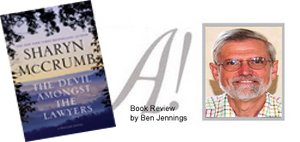

Fans of Sharyn McCrumb's fiction will be pleased to know that, after an eight-year digression into the world of NASCAR (and three novels that resulted from this interest) - McCrumb has returned to the type of work at which she excels.
Her new "Ballad novel," The Devil Amongst the Lawyers, will be released June 22, 2010.
McCrumb stated her original intentions for the Ballad series in the prologue to her first "Ballad novel" If I Ever Return, Pretty Peggy-O in 1990: "Appalachia is still trying to live down the stereotypical "backwoods' view of the region presented by the media. I think one of the best ways to combat this negative portrayal is to educate the general reader about the real character of the region and particularly about the history and origins of Appalachia and its people, both culturally and environmentally."
After 20 years and seven "Ballad novels," The Devil Amongst the Lawyers deals directly with the origins of many of the negative portrayals of the region in the national media as they began to be widely promulgated in the 1930s when magazines, radio, and movies presented the backwoods Appalachian mountaineer as a solace for urban readers in the midst of the Great Depression. ("Your lives could be worse. Look how bad it is in some parts of the country!")
This is McCrumb's first novel to be set in far Southwest Virginia, primarily Wise and Pound, but also Abingdon and Bristol.
The actual historical event at the center of the novel is the murder of Trigg Maxwell in 1935 in Pound. The accused murderer was his 21-year-old daughter Edith, an elementary school teacher and a recent graduate of Radford College. The national media sensationalized the "wronged woman on trial" against the backdrop of the backwardness and poverty of mountain life.
While the novel revolves around the murder trial of Edith Maxwell (fictionalized to Erma Morton), the focus is on the big-city reporters who resent being assigned to such a remote area; while living in Manhattan, they commuted daily to the trial in New Jersey of the kidnapper and murderer of the Charles Lindbergh baby.
The central character is Henry Jernigan, a reporter who has had to lower his literary standards during the Depression to write sensational journalism. The narrator describes Jernigan's role: "This time a backwoods coal miner had got his head bashed in, and because the culprit. . .was a beautiful, educated girl, the newspaper editors thought that Mr. and Mrs. America would eat it up. Provided, of course, it was served to them in a palatable stew of sex, drama, and exotic local color. Henry was just the chef to concoct this tasty dish."
Rose Hanelon is a "sob sister" (as female journalists were called in that era) from the New York Herald Tribune, assigned to describe beautiful, innocent victims. Her philosophy of journalism is that "Nobody deals in truth. . . .Truth is what you can convince people to believe."
The hero is Carl Jennings from the Johnson City newspaper, who files accurate reports of the trial as well as realistic portrayals of the people from the Wise and Pound communities. His editor complains that Jennings is too young and innocent to understand the entertainment component of news reporting.
Readers who have read the earlier Ballad novels will remember the recurring characters from novel to novel, especially Nora Bonesteel. Here she appears as a 13-year-old cousin of Jennings. Through her gift of "the sight," she tries to help him scoop the big-city reporters.
McCrumb is always an excellent researcher. In this novel, you learn about the impact that The Trail of the Lonesome Pine (both novel and film) had on shaping the nation's false perception of Appalachia, what Abingdon was like in the 1930s (the reporters spend the night there), how live radio performances at WOPI in Bristol were conducted, and hundreds of other accurate details of life in the area in the 1930s.
Many of the characters in McCrumb's novels are spokespeople for the issues that she dramatizes in her work. That is the case here, too, but sensationalizing the national news and the accuracy of journalism 75 years later are very important topics today as well.
It's not giving the plot of the novel away to reveal that the real Edith Maxwell was convicted of murder, perhaps falsely. She served four years in prison before public opinion - and a special plea from First Lady Eleanor Roosevelt - persuaded Gov. James Price to pardon her.
About the Reviewer: Ben Jennings is Associate Professor of English and Coordinator of the Arts Array Series at Virginia Highlands Community College in Abingdon. He is a founding member of the editorial committee for A! Magazine for the Arts.